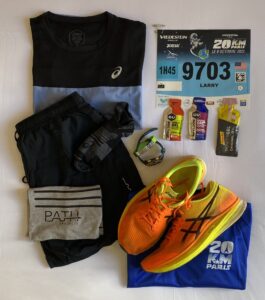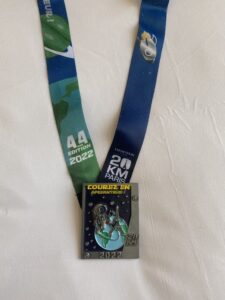How is launching a new product like running in a long distance race?
Larry Yost | October 1, 2023 | Blog Post
 As many of my clients know, I am a runner. Since I founded The Atticus Group 14 years ago, I have run and completed a number of long distance races including the Seacoast (Portmouth) Half Marathon numerous times, the 20 kilometes of Paris eight times, and the Paris marathon. I cannot help comparing how running in long distance races is similar to the effort required for a start-up company to bring a new medical technology to the market. Below I have attempted to highlighted these similarities.
As many of my clients know, I am a runner. Since I founded The Atticus Group 14 years ago, I have run and completed a number of long distance races including the Seacoast (Portmouth) Half Marathon numerous times, the 20 kilometes of Paris eight times, and the Paris marathon. I cannot help comparing how running in long distance races is similar to the effort required for a start-up company to bring a new medical technology to the market. Below I have attempted to highlighted these similarities.
Preparing for the Race – The Importance of Training
Much like you can’t run a long distrance race without training, you can’t launch a new, innovative technology with paying your dues over time learning how to successfully develop and commercialize a product. I ran nearly 1,000 miles over the last year as a part of my training regimen prior to the 20 km race in Paris. This included painful early (short distance) runs when I was trying to get into shape, middle distance runs which eventually became 60, 75 and 90 minute runs as the year progressed, core body training, and speed/interval workouts at the local high school track to help increase my running pace.
The above is similar to the types of experience employees at start-up companies need to have in order to successfully launch an innovative new product. This includes employees with experience at both large, multinational companies and with small companies in a start-up environment. Many of these individuals have experienced “painful” learning lessons as their careers have advance, and hopefully, enjoyed the thrill of success associated with crossing the finish line by commercializing technologies at other companies. Similar to mixing up training, it’s important that companies hire a mix of individuals with varying types of experiences in order to build a stronger team.
Race Day
 It’s the day of the race. You need to know in advance what time the race starts, where the start and finish lines are, what the weather is going to be, what to wear, and insure that you eat the right foods the day before and the morning of the race. For start-up companies, you need to know what the market dynamics are for you technology. What is the market potential, what is the true medical need, how does the product need to be positioned, what is the regulatory pathway, what are the barriers to entry, how will the product be reimbursed, how will you manufacture the product, and importantly, what margins can you expect to achieve when selling the product? All of the above, and more, is information you will need in order to obtain the funding the company needs to fuel its efforts. Think of this funding as your pre-race energy gel.
It’s the day of the race. You need to know in advance what time the race starts, where the start and finish lines are, what the weather is going to be, what to wear, and insure that you eat the right foods the day before and the morning of the race. For start-up companies, you need to know what the market dynamics are for you technology. What is the market potential, what is the true medical need, how does the product need to be positioned, what is the regulatory pathway, what are the barriers to entry, how will the product be reimbursed, how will you manufacture the product, and importantly, what margins can you expect to achieve when selling the product? All of the above, and more, is information you will need in order to obtain the funding the company needs to fuel its efforts. Think of this funding as your pre-race energy gel.
The Crowded Field at the Starting Line
With over 25,000 runners, the start of the Paris 20K race can be treacherous. You need to avoid tripping over other runners, elbows and pushes (and some name calling) from highly competitive individuals who surround you, and watching your every step in order to safely leave the start area at beginning of the race. This is no different from the competition you will face when you pursue potential angel funding, venture capital, or deals with strategic companies in order to fund the development of your technology. The key is to have a plan, know your start strategy, and importantly, you need to reconnoiter the course, especially the first 1 to 2 kilometers of the race, in advance, and determine what you need to get off to a good start. It is also vital that you don’t sprint out at the start of the race and use up all of your energy. This will result in you running out of gas and failing to achieve the finish line (or finishing at a painfully slow pace that insures you will not achieve your desired finish time).

When pursuing funding, have a plan in place, obtain coaching on your strategy from experienced individuals, insure you have a presentation that provides the information potential investors are looking for, and lastly, make sure you separate yourself from other companies (competitors) so that you don’t get elbowed out of the way.
The Long Journey
Seeing the kilometers tick off as you journey through Paris helps propel you forward even though your body is tiring from the pace of the race. There are flags at each kilometer mark which not only remind you of how far you have come, but also remind you of how far you have left to go! It’s important to remain hydrated (there are 3 water stops along the race routes at 5k, 10k, and 15k) and to use an energy gel pack (or two) along the way to ensure you can make it to the finish line. Keeping a watch on your pace (using either your watch or GPS tracking technology) at each kilometer mark will let you know if your pace is on track to achieve your desired finish time or if you are lagging.
Similarly, its important for start-up companies to achieve specific milestones as they execute their development and pre-commercialization strategy. These milestones need to be time sensitive enabling the company to achieve the pre-determined launch date for their product. Similar to runners, it important to “top off the tank” with additional funding, in order to insure you the company can bring the product to commercialization with sufficient cash on hand to successfully launch the product.
The Finish Line (sort of)
 With good preparation (training) and planning, the last few kilometers of the race can be enjoyable. For the Paris 20K, the 17 km mark is where you cross back over the River Seine after passing the Louvre. With only 3 km to go, you can see the Eiffel Tower, and while your legs are screaming at you to stop, you can smell the finish line. This is no different when you launch a new technology. The road has been long and hard and most of the company’s employees are overworked and exhausted after solving problems and making the final push to get the product to market. Once the day of product launch arrives, the company can celebrate crossing the finish line and bask in the glory of having accomplish this goal.
With good preparation (training) and planning, the last few kilometers of the race can be enjoyable. For the Paris 20K, the 17 km mark is where you cross back over the River Seine after passing the Louvre. With only 3 km to go, you can see the Eiffel Tower, and while your legs are screaming at you to stop, you can smell the finish line. This is no different when you launch a new technology. The road has been long and hard and most of the company’s employees are overworked and exhausted after solving problems and making the final push to get the product to market. Once the day of product launch arrives, the company can celebrate crossing the finish line and bask in the glory of having accomplish this goal.
It’s also imporant to know that there will be other challenges ahead after the inital launch of your product just like I have other races in the future. This includes my plan to run the Frankfurt marathon in 2024. This longer and more grueling race is similar to the long-term effort that is needed to achieve market success after the product launch.
